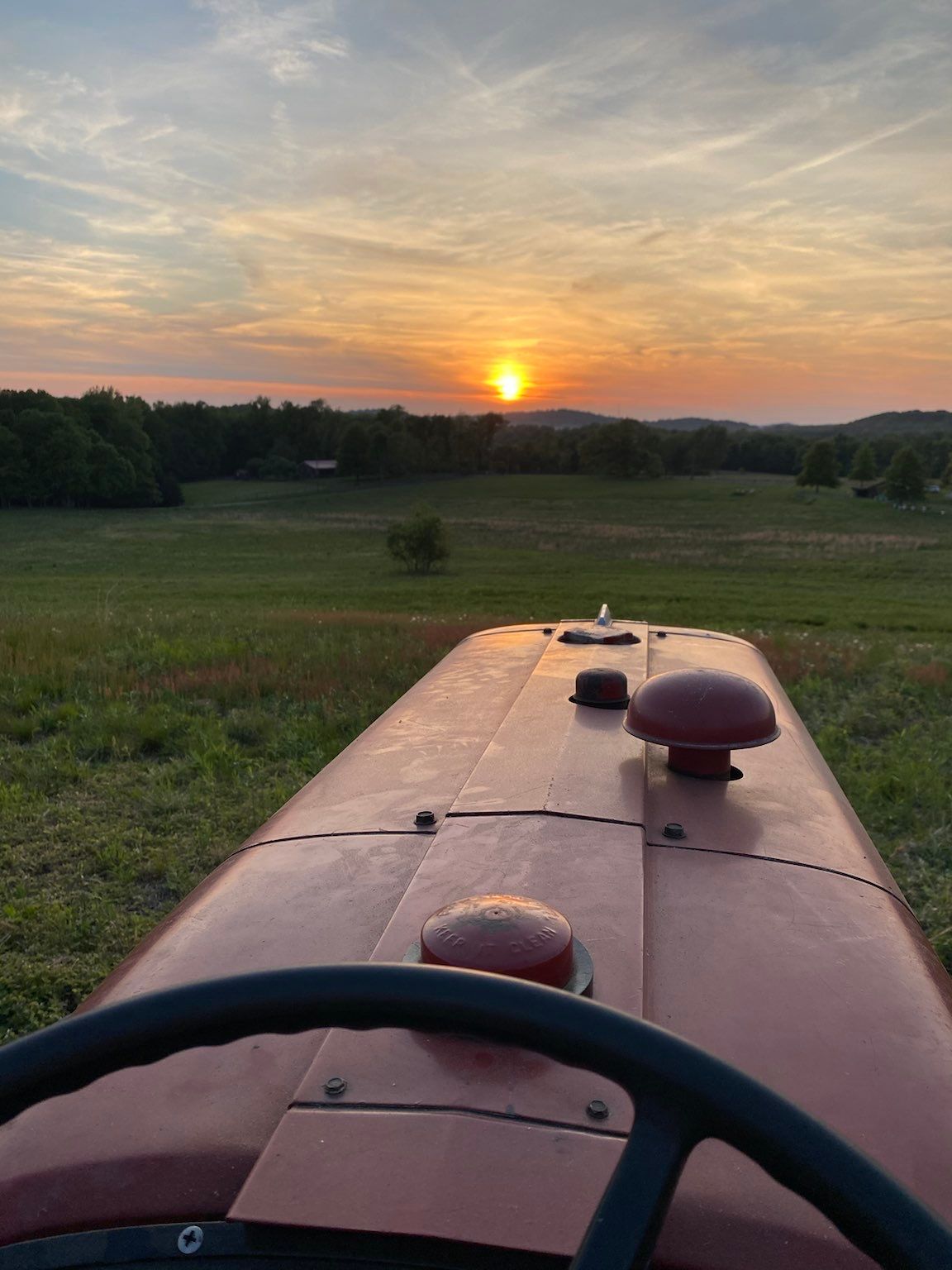Capture. Organize. Create. Repeat.

We started yesterday with a discussion about time management.
This discussion centered on hard and soft entires to your schedule, where a hard entry is one with a specific time and a soft one is not.
My first takeaway was that I wanted to be mindful of giving more things hard times on my schedule - especially non work things that are still highly important. The second takeaway was that I wanted to give hard stop times and treat them like real deadlines.
Chesley, Mike, and I realized that this was a subject that we wanted to dive into further. Time and task management has been a challenge on the farm. No matter how much we do, there are always a seemingly infinite amount of urgent and important things ahead of us.
A feeling that we are behind is pervasive. We are definitely guilty of what I talked about yesterday - we over budget our time by creating a list of many important things to do without hard times given regarding when we start work and when we finish.
This has significant implications. The most dire is the fact that without a clear time period for a task, we end up attempting to do more of a project than is actually possible in a day. Rather than help get things done faster, this leads to huge amounts of wasted time.
Here is a real example, with real consequences.
We’ve been having an issue with the neighbor’s dog coming onto the farm and catching chickens and ducks.
For the winter, I want the birds in the hoop house. This will give them plenty of space, warmth, and protection from the wind. It will also help us create compost because we’ll be using the “deep litter” method to keep the ground they are on clean and dry.
As it related to the dog, keeping the birds in the hoop house also makes it easy to keep them safe until we can make sure she doesn’t come over here anymore.
In order to complete this project, here is my list of tasks:
- Reinstall the back door
- Fix the back left corner
- Install an interior fence and gate to keep the birds contained inside and away from the plastic
- Set up roosts
- Set up egg boxes
The problem is that I didn’t treat these like discrete tasks.
In fact, this is the first time I’ve ever stopped to consider what I actually need to do to finish the project. Up until now, every time this has gone on my schedule, it’s gone on as “get chickens in hoop house”.
Being the optimistic person that I am, I look at that and think that I’ll take care of that “in the morning”.
You can probably already guess what happens. I head over to the hoop house, take mental stock of the things that need done, and realize that it might be more than I expected. No worries, I’ll just work faster. I start with the door, then after investing about 20 minutes, I realize I don’t have the hinges I need. I’ll deal with that later, for now I’ll move on.
This story repeats with false starts over hundreds of projects, often with tools left in place with the also optimistic hope that I’ll be back to work on it before the day is over.
The consequence? The birds are not contained, and the dog is still catching them. Time is burned with no results.
Given the importance, yesterday morning we decided to have an impromptu farm meeting about how we can improve on this. Mike asked me to share the notes with him, and I promised him I'd type them up and share them here.
How We Plan to Improve on Our Scheduling Process
In previous farm meetings, we’ve been working on our “holistic context”. This involves identifying “quality of life statements” and “modes of production”. We used this format for figuring out what exactly we want to achieve and what we need to do in order to achieve it.
Here are the quality of life statements we came up with. The second two could be looked at as derivatives of the first, but we’ll leave them as separate things for now.
We feel good throughout and about the day. As we go through the day, we feel good about what we are doing. Our energy levels are high. We are enthusiastic about our work. At the end of the day, the same is true. When we look back at what we have done, we feel good. This applies to larger time frames as well.
We feel confident in task selection. In other words, we feel good about what we’re choosing to do. We know what is important. Things aren’t slipping through the cracks, and we know it.
Important things get done. Our time and energy is being invested into the things that are most important to us. These things are actually being completed.
Now that we have our quality of life statements, we can identify our “modes of production”. What are we actually going to do to make these things a reality?
Something that applies to all three of these statements is that we must know what is important.
How do we achieve this?
- We keep a list of what roles are important to us.
- We capture ideas in a “commonplace book” or note taking app in real time.
- We organize these ideas into a system that makes the ideas accessible when we need them.
- We use this organizing system each night to prepare for the next day.
- We review our plan each morning.
- We do a similar process on a weekly, monthly, and yearly level.
A few notes on some of these items:
I’ve learned from Stephen Covey and Tony Robbins that a good first step is identifying your roles before you think about your goals. For example, I am a husband, father, farmer, friend, and individual, among others. I think it’s important to keep a list of your roles because sometimes a glance at this list will make you realize you are sacrificing something important in the name of production in some other area.
How many times do we have to hear stories of people at the end of their lives saying they wish they would have invested more time into their family and friendships before we listen?
If we are going to fill our schedule with the things that are actually the most important, we need a mechanism that reminds us of the things we overlook. This list can help.
Next, we need a “commonplace book”. This is a place to capture all the thoughts and ideas we have. In the book Getting Things Done, David Allen points out “Our brains are for having ideas, not for holding them.”
For me, this is a small pocket sized Moleskin notebook. Any note taking app could work as well. The key thing is it needs to be with you all the time, and you need to get in the habit of writing down your ideas. Don’t count on remembering it. Guarantee it by putting it on paper.
Next we need a process for organizing all these ideas. Once you’ve captured all these ideas, you need to actually use them. Sometimes you’ll be able to take care of something immediately by doing it right away or by putting it straight on the schedule. More often, you’ll want to hold these ideas for later reference or scheduling.
For this, you need a system.
In Getting Things Done, David Allen provides an excellent workflow for how to process ideas once you’ve captured them. You can see this below.

I’m not going to go over the whole process. If you are interested, I recommend the book. It is worth reading.
Another book that I am looking into is called Building a Second Brain by Tiago Forte. If anyone has any experience on this, let me know.
For now, my plan is to use a tool called Notion for organizing all this and developing it into a schedule. I will update further on this front in the future.
So far we’ve covered what we need to do to know what is important. Next we need to get the important things done. Here are the modes of production for this:
- We perform project planning in order to identify the specific tasks that need completed within a project, as well as any materials or knowledge that needs gathered before beginning.
- We schedule tasks.
- We identify what “complete” means for the task.
- We give ourselves a deadline.
- We honor the deadline.
- Done includes putting tools back where they belong.
Finally, let’s circle back to the original statement that “We feel good throughout and about the day.”
There are some extra modes of production that we must include to ensure this is accomplished.
- We are mindful of energy and give ourselves time to “charge”. We recognize that a short break can make a huge difference in attitude and productivity.
- We take the time to connect what we are doing to our “why”.
- Rest = Rest. Time scheduled for rest is honored and not used to “catch up”. During rest time, we will guard against stimulation.
I am at my deadline and need to move on from this, but I think I was able to convey the most important things even if I may not have done it as eloquently as I would have liked.
We think these processes will put us on the path to getting more things done while feeling better throughout and about each day.
What do you think? Have we overlooked anything?
It's been pointed out that not only do I not have a commenting feature, you also can't reply to the email that is sent out. If you want to send thoughts, for now just email me at dylan.heagy@gmail.com.
Thanks for reading!
Life is good!
